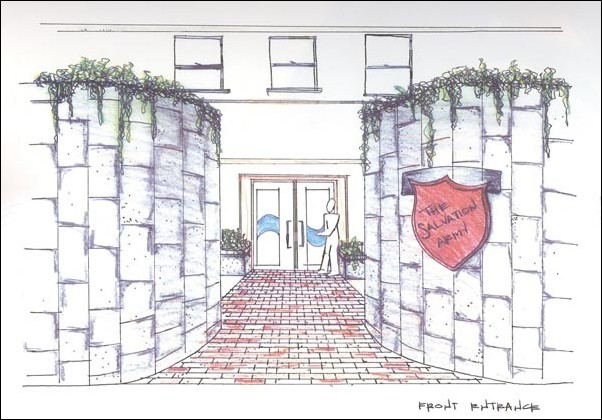Design students draw upon skills
Image: Design students draw upon skills:Kerri Ann Echida, Evon Blondi, Wende Seely and Sarah Redeen all contributed to this rendering of the planned shelter. Special to the State Hornet:
November 10, 2004
For a group of Sacramento State design students on the verge of graduation, teaming up with Salvation Army to help the homeless is the final test before garnering their degrees.
Professors Jill Pable, Gwen Amos and Johanna Latty in Sac State’s design department are leading students to work in conjunction with the Salvation Army’s Center of Hope Social Services Center in downtown Sacramento. Their goal is to take the current one-floor, 80-bed homeless shelter and turn it into a three-story, 200-bed community to help people in crisis get back on their feet.
“We’re a shelter that’s open 24/7/365, and we help people reclaim their life back,” said Larry Dayton, program coordinator at the center.
Dayton, an employee of the Salvation Army for the past six years, said that the Social Service Center is a place that does not just serve meals. He said it examines the reasons why its clients are in such a difficult situation, and help them get back to the point of self-sufficiency.
Within the design department, students majoring in graphic design, interior design and photography are working together to help deliver on this project.
In Pable’s advanced interior design classes, students have been divided into two groups each attacking the project at a different angle. Pable states that each group is devising two different design plans for the shelter.
One design, called the visioning plan, represents more of an ideal of what the shelter could look like given a sufficient amount of funds and resources. The other, called the grant based design, represents a more realistic approach of using $500,000, a typical sized grant the Salvation Army receives, to refurbish those parts of the shelter that need the most attention.
“Right now, the students have just completed the concept design stage of the project, and received a lot of positive feedback for their efforts,” Pable said.
Students presented their visions for the shelter Oct. 28 to Dayton, his staff and some of the homeless clients currently residing at the shelter. The students prepared conceptual drawings, floor plans and a 150-page research document that they compiled over the course of the semester.
This document included survey results and testimonies that the students compiled from homeless clients and staff at the shelter. Pable said the best opportunity the students have taken advantage of was their trip to San Francisco. While there, they visited different shelters and gathered information to find out what has worked at other shelters and what needs the most improvement.
“What was great about the students’ presentation was that they tried to encompass everything that the Salvation Army does,” Dayton said. “You could tell their hearts were in it all the way.”
Pable said they covered everything from security issues, to psychological comfort, to the lighting and even the overall function of the shelter and how that would affect the clients’ healing.
In addition, she said the homeless clients had a lot of helpful suggestions as the collaboration between everyone at the presentation left the students with a better understanding as to how they should approach the project in the weeks ahead.
One idea that Dayton particularly enjoyed was the students’ idea of creating a hope wall. Amos’ graphic design students, along with three of Latty’s photo students, are collaborating to create a wall that will allow current residents to place pictures, write stories and leave small items to inspire others to reclaim their lives.
“Even if we don’t get the funds we hoped for, I personally hope that we can secure private donations that would still allow us to give the wall to the Center of Hope,” Pable said.
This project is the first time that Sac State’s design department has taken on a task this size. In the past, the department has designed a travel literacy bus for Yolobus as well as some facilities on campus.
Aside from the real-life experience her students are receiving, Pable stated that the biggest reward her students are getting is the chance to work with the homeless.
“It’s been an incredibly humanizing experience for all of us,” Pable said. “Once the students got to know the homeless clients on a more personal level, they realized that they were no different than any of us.”
Now that the first half of the semester is over, the students will move into the design development stage. On Dec. 7 and 9, a final presentation will be made to Dayton and his staff showcasing the final aesthetic vision of the Sac State students.
Besides increasing the size of the facility, the students are working to include elements such as a barbershop, a bank and a performance stage amongst others to help the homeless regain confidence to take their lives back.





























































































































